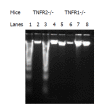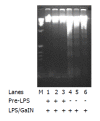Lethal effect and apoptotic DNA fragmentation in response of D-GalN-treated mice to bacterial LPS can be suppressed by pre-exposure to minute amount of bacterial LPS: dual role of TNF receptor 1
- PMID: 15948245
- PMCID: PMC4315994
- DOI: 10.3748/wjg.v11.i22.3398
Lethal effect and apoptotic DNA fragmentation in response of D-GalN-treated mice to bacterial LPS can be suppressed by pre-exposure to minute amount of bacterial LPS: dual role of TNF receptor 1
Abstract
Aim: To investigate whether induction of tolerance of mice to lipopolysaccharide (LPS) was able to inhibit apoptotic reaction in terms of characteristic DNA fragmentation and protect mice from lethal effect.
Methods: Experimental groups of mice were pretreated with non-lethal amount of LPS (0.05 microg). Both control and experimental groups simultaneously were challenged with LPS plus D-GalN for 6-7 h. The evaluations of both DNA fragmentations from the livers and the protection efficacy against lethality to mice through induction of tolerance to LPS were conducted.
Results: In the naive mice challenge with LPS plus D-GalN resulted in complete death in 24 h, whereas a characteristic apoptotic DNA fragmentation was exclusively seen in the livers of mice receiving LPS in combination with D-GalN. The mortality in the affected mice was closely correlated to the onset of DNA fragmentation. By contrast, in the mice pre-exposed to LPS, both lethal effect and apoptotic DNA fragmentation were suppressed when challenged with LPS/D-GalN. In addition to LPS, the induction of mouse tolerance to TNF also enabled mice to cross-react against death and apoptotic DNA fragmentation when challenged with TNF and/or LPS in the presence of D-GalN. Moreover, this protection effect by LPS could last up to 24 h. TNFR1 rather than TNFR2 played a dual role in signaling pathway of either induction of tolerance to LPS for the protection of mice from mortality or inducing morbidity leading to the death of mice.
Conclusion: The mortality of D-GalN-treated mice in response to LPS was exceedingly correlated to the onset of apoptosis in the liver, which can be effectively suppressed by brief exposure of mice to a minute amount of LPS. The induced tolerance status was mediated not only by LPS but also by TNF. The developed tolerance to either LPS or TNF can be reciprocally cross-reacted between LPS and TNF challenges, whereas the signaling of induction of tolerance and promotion of apoptosis was through TNFR1, rather than TNFR2.
Figures





Similar articles
-
A striking correlation between lethal activity and apoptotic DNA fragmentation of liver in response of D-galactosamine-sensitized mice to a non-lethal amount of lipopolysaccharide.Acta Pharmacol Sin. 2003 Mar;24(3):193-8. Acta Pharmacol Sin. 2003. PMID: 12617765
-
Tolerance of mice to lipopolysaccharide is correlated with inhibition of caspase-3-mediated apoptosis in mouse liver cells.Acta Biochim Biophys Sin (Shanghai). 2007 Feb;39(2):96-100. doi: 10.1111/j.1745-7270.2007.00253.x. Acta Biochim Biophys Sin (Shanghai). 2007. PMID: 17277883
-
Etoposide prevents apoptosis in mouse liver with D-galactosamine/lipopolysaccharide-induced fulminant hepatic failure resulting in reduction of lethality.Hepatology. 2001 Jun;33(6):1441-50. doi: 10.1053/jhep.2001.24561. Hepatology. 2001. PMID: 11391533
-
Secoisolariciresinol and isotaxiresinol inhibit tumor necrosis factor-alpha-dependent hepatic apoptosis in mice.Life Sci. 2004 Apr 16;74(22):2781-92. doi: 10.1016/j.lfs.2003.10.021. Life Sci. 2004. PMID: 15043992
-
D-galactosamine lethality model: scope and limitations.J Endotoxin Res. 2004;10(3):147-62. doi: 10.1179/096805104225004879. J Endotoxin Res. 2004. PMID: 15198850 Review.
Cited by
-
Bcl-3 promotes TNF-induced hepatocyte apoptosis by regulating the deubiquitination of RIP1.Cell Death Differ. 2022 Jun;29(6):1176-1186. doi: 10.1038/s41418-021-00908-7. Epub 2021 Dec 1. Cell Death Differ. 2022. PMID: 34853447 Free PMC article.
References
-
- Galanos C, Freudenberg MA, Katschinski T, Salomão R, Mossmann H, Kumazawa Y. Tumor Necrosis Factor and Host Response to Endotoxin. In: Ryan J, Morrison DC, eds , editors. Bacterial Endotoxic Lipopolysaccharides. Vol II–Immunopharmacology and Pathophysiology. New York: Marcel Dekker, CRC Press; 1992. pp. 75–104.
-
- Zentella A, Manogue K, Cerami A. The role of cachectin/TNF and other cytokines in sepsis. Prog Clin Biol Res. 1991;367:9–24. - PubMed
-
- Pallua N, von Heimburg D. Pathogenic role of interleukin-6 in the development of sepsis. Part I: Study in a standardized contact burn murine model. Crit Care Med. 2003;31:1490–1494. - PubMed
-
- Tartaglia LA, Pennica D, Goeddel DV. Ligand passing: the 75-kDa tumor necrosis factor (TNF) receptor recruits TNF for signaling by the 55-kDa TNF receptor. J Biol Chem. 1993;268:18542–18548. - PubMed
-
- Chen G, Goeddel DV. TNF-R1 signaling: a beautiful pathway. Science. 2002;296:1634–1635. - PubMed
Publication types
MeSH terms
Substances
LinkOut - more resources
Full Text Sources

